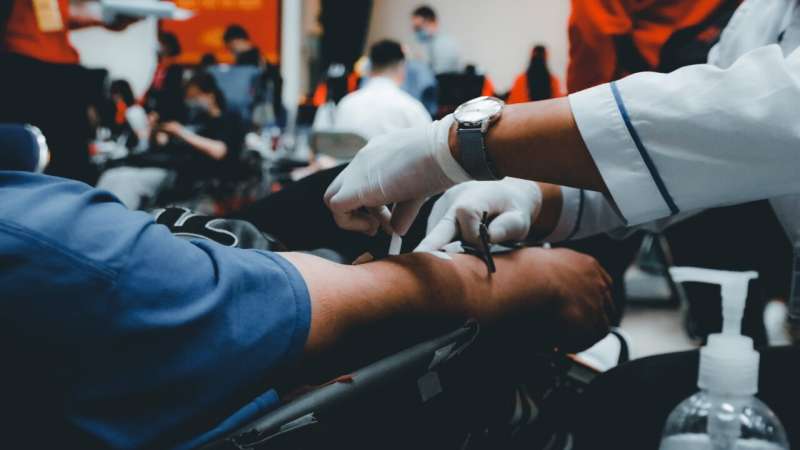Understanding Blood Loss and Mortality
Blood is essential for life. It carries oxygen and nutrients throughout our body and helps remove waste products. Severe blood loss represents a medical emergency that requires prompt attention. But how much blood can a person lose before it becomes deadly? Here's an in-depth look at the effects of blood loss and how much is too much.
How Much Blood Do We Have?
On average, an adult human has about 1.2-1.5 gallons (4.5-5.5 liters) of blood circulating in their body. This represents approximately 7% of total body weight. For example, someone weighing 150 pounds would have around 10.5 pounds of blood.
Blood volume varies by age and size. Men tend to have more blood than women. Newborns start with around 1 cup of blood, and blood volume increases to adult levels by puberty.
Functions of Blood
Blood has three main functions:
- Transport - Blood carries oxygen from the lungs and nutrients from the digestive system to tissues throughout the body. It also transports carbon dioxide and waste products away from tissues to be removed from the body.
- Regulation - Blood helps regulate body temperature, fluid balance, and pH levels.
- Protection - Blood clots to prevent excess blood loss after injury. It also contains immune cells and proteins that help fight infection.
Classes of Blood Loss
Doctors classify blood loss into four classes based on the percentage of total blood volume lost:
- Class I - Up to 15% blood volume lost (up to 750mL for an average adult)
- Class II - 15-30% blood volume lost (750-1500mL)
- Class III - 30-40% blood volume lost (1500-2000mL)
- Class IV - Over 40% blood volume lost (over 2000mL)
Effects of Blood Loss
The effects of blood loss depend on how quickly and how much is lost. Here's an overview of the potential effects at different levels of blood loss:
Up to 15% Blood Loss (Class I)
Most healthy adults can tolerate losing up to 15% of their blood volume. Effects are usually minor and may include:
- Slightly elevated heart rate
- Pale skin
- Fatigue or lightheadedness
This degree of blood loss typically does not require transfusion. The body can usually reabsorb the lost fluid within 24 hours.
15-30% Blood Loss (Class II)
Losing 15-30% of blood volume starts to have more significant effects, including:
- Rapid heart rate
- Low blood pressure (hypotension)
- Fainting or dizziness upon standing
- Shortness of breath
- Cold, clammy skin
At this level of blood loss, emergency medical care is needed to replace lost fluid and blood. Transfusion may be necessary to restore adequate circulation.
30-40% Blood Loss (Class III)
Losing 30-40% of blood volume leads to severe symptoms including:
- Markedly low blood pressure
- Rapid, weak pulse
- Shock
- Confusion
- Unconsciousness
This degree of blood loss represents a life-threatening medical crisis. Immediate emergency treatment is vital to replace volume and blood cells. Without transfusion, cardiovascular collapse and death can occur rapidly.
Over 40% Blood Loss (Class IV)
Losing over 40% of blood volume is typically fatal without prompt emergency treatment. Severe effects include:
- Profound shock
- Total loss of consciousness
- Absent or thread pulse
- Cardiac arrest
- Death
Rapid blood volume replacement and transfusion are critical to survival. However, resuscitation may still fail at this degree of hemorrhage.
How Long Can You Survive Without Blood?
Survival time after major blood loss depends on multiple factors, including:
- Amount of blood lost
- Rate of blood loss
- Age and overall health
- Other injuries or medical conditions
- Availability of medical treatment
In general, here's how long someone may survive with different degrees of blood loss:
- Up to 15% blood loss - Most healthy adults survive without treatment
- 15-30% blood loss - Survival likely if treated within 1-2 hours
- 30-40% blood loss - Survival possible with treatment within minutes
- Over 40% blood loss - Survival unlikely without immediate resuscitation
With rapid blood loss, irreversible shock and death can occur within minutes. But more slowly progressing blood loss may be tolerated for hours depending on the circumstances.
Can You Survive Without Any Blood?
No, the human body cannot survive without blood circulation for more than a few minutes. Blood carries oxygen that is absolutely vital for cell and organ function. Without oxygen delivery, cells quickly die and organs like the brain and heart rapidly fail.
Animal experiments in the 1940s showed that total exsanguination (complete blood loss) universally leads to death within 2 minutes. However, smaller blood volumes and slower rates of blood loss can sometimes be survived, especially with medical treatment.
Emergency Treatment for Severe Blood Loss
Prompt medical treatment is vital for survival after major blood loss. Key emergency measures may include:
- Controlling bleeding - Use direct pressure, tourniquets, or hemostatic agents to stop ongoing bleeding after injury.
- IV fluids - Replace lost fluid volume by giving isotonic crystalloid solution through an IV line.
- Blood transfusion - Transfer donated blood to replace blood cells and restore oxygen delivery.
- Treating shock - Give oxygen, fluids, and medications to improve blood pressure.
- Surgery - Repair injuries causing internal or external bleeding surgically.
In the hospital, severely injured patients may require admission to the intensive care unit for close monitoring and treatment. With modern trauma care, survival is possible even after losing up to half of blood volume.
Blood Transfusion Risks
Receiving blood through transfusion is generally very safe. But there are some potential risks to be aware of:
- Infections - Donated blood is screened, but a small risk of viral infections like HIV or hepatitis exists.
- Reactions - Allergic, febrile, or hemolytic reactions can rarely occur.
- Volume overload - Receiving too much blood can lead to pulmonary edema.
- Incompatible blood - Mismatched blood types can cause a transfusion reaction.
Doctors weigh these low risks against the potential benefits when deciding whether transfusion is appropriate for major blood loss.
Preventing Uncontrolled Blood Loss
Many cases of severe blood loss can be prevented by prompt treatment of underlying medical conditions or injuries that damage blood vessels or organs. Here are some prevention tips:
- Manage high blood pressure and atherosclerosis to prevent aneurysms or strokes.
- Get screening tests like colonoscopies to detect early cancers or polyps.
- Take medications properly to prevent ulcers of the stomach, intestines, or esophagus.
- Prevent traffic accidents by driving cautiously and avoiding impairment.
- Handle sharp objects safely and store guns properly to avoid penetrating trauma.
- Wear seat belts and helmets to reduce injury severity from crashes.
Learning basic first aid and stopping initial bleeding from an injury can also greatly improve outcomes until expert medical care is available.
Key Takeaways
- An average adult has 4.5-5.5 liters of blood in their body, which equals around 7% of total body weight.
- Up to 15% blood volume loss is often well tolerated, while losses over 40% are typically fatal without rapid resuscitation.
- Survival after major hemorrhage depends on the amount and rate of blood loss and availability of medical treatment.
- Prompt measures like controlling bleeding, IV fluids, blood transfusions, and treating shock are crucial for saving lives after severe blood loss.
- Careful prevention of injuries and conditions leading to uncontrolled bleeding is key to avoid potentially deadly blood loss.
Blood is essential for life, but the human body can often survive and recover from seemingly massive volumes of blood loss with proper emergency treatment. Understanding the effects of hemorrhage allows doctors to rapidly initiate lifesaving therapies for both trauma and medical conditions causing dangerous levels of bleeding.
FAQs
How much blood does the average adult have in their body?
The average adult has between 4.5-5.5 liters of blood, which equates to about 7% of total body weight.
What happens if you lose up to 15% of your blood?
Losing up to 15% of blood volume typically causes only minor symptoms like fatigue, lightheadedness, and pale skin. This degree of blood loss can usually be recovered from without transfusion.
What are the symptoms of losing 30-40% of blood volume?
Losing 30-40% of blood leads to shock, markedly low blood pressure, rapid/weak pulse, confusion, unconsciousness, and possible cardiovascular collapse and death without prompt emergency treatment.
How long can someone survive after losing over 40% of their blood?
Losing over 40% of blood volume is typically fatal within minutes without immediate resuscitation and blood volume/component replacement. However, in some cases survival is possible with extremely rapid treatment.
What emergency treatments can help save someone's life after major blood loss?
Key emergency treatments for severe hemorrhage include stopping the source of bleeding, giving IV fluid replacement, blood transfusion, medications for shock, and urgent surgical control of bleeding if needed.
Disclaimer: This article is for informational purposes only and does not constitute medical advice. Always consult with a healthcare professional before starting any new treatment regimen.
Related Coverage
Check if Medicare cover cane costs, cane types, required prescription, and out‑of‑pocket share after the Part B deductible....
Doing crossword puzzles regularly can help improve memory, concentration, and reasoning in aging adults. Crosswords engage broader cognitive skills than brain games....
Compare Medicare Part A vs Part C (Medicare Advantage) to find out which coverage fits your health needs and lifestyle....
Compare Michigan Medicare plans and choose the right coverage for your health needs. Get support and save money....
Cats can provide companionship, mental stimulation, and comfort for seniors with dementia. Learn how cats benefit dementia patients and tips for integrating a feline companion....
Get clear info on Kentucky Medicare options including coverage, costs, and enrollment to make the best healthcare choice....
Get clear info on Medicare Part B cost for 2025, including premiums, deductibles, and ways to lower what you pay each month....
Get expert Medicare enrollment help to choose the right coverage. Avoid penalties and make informed decisions with our guide....
Get clear, local insights on Medicare in Hawaii. Compare plans, understand coverage, and make confident healthcare choices for your island lifestyle....
Secondary aging is influenced by lifestyle and health choices. Learn how to slow it down and age healthier....









